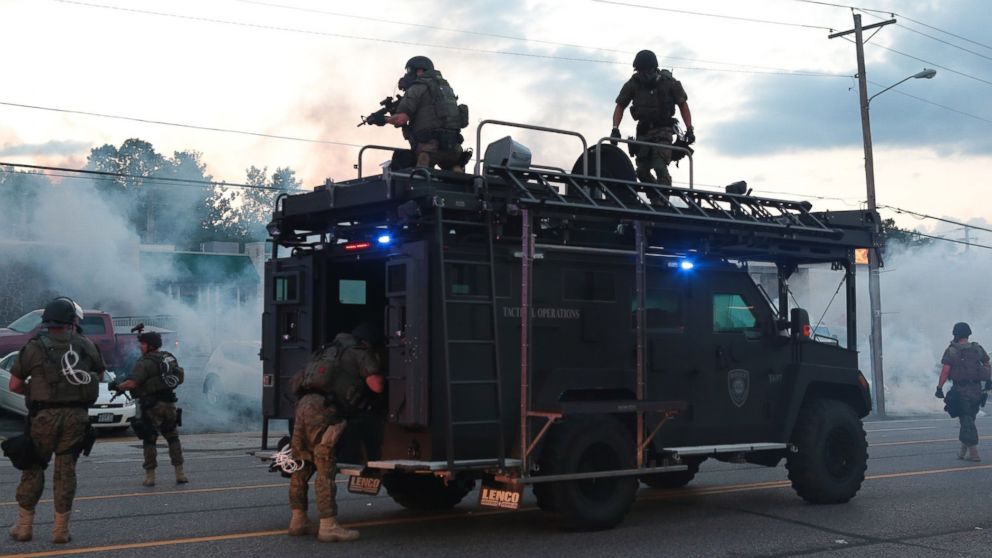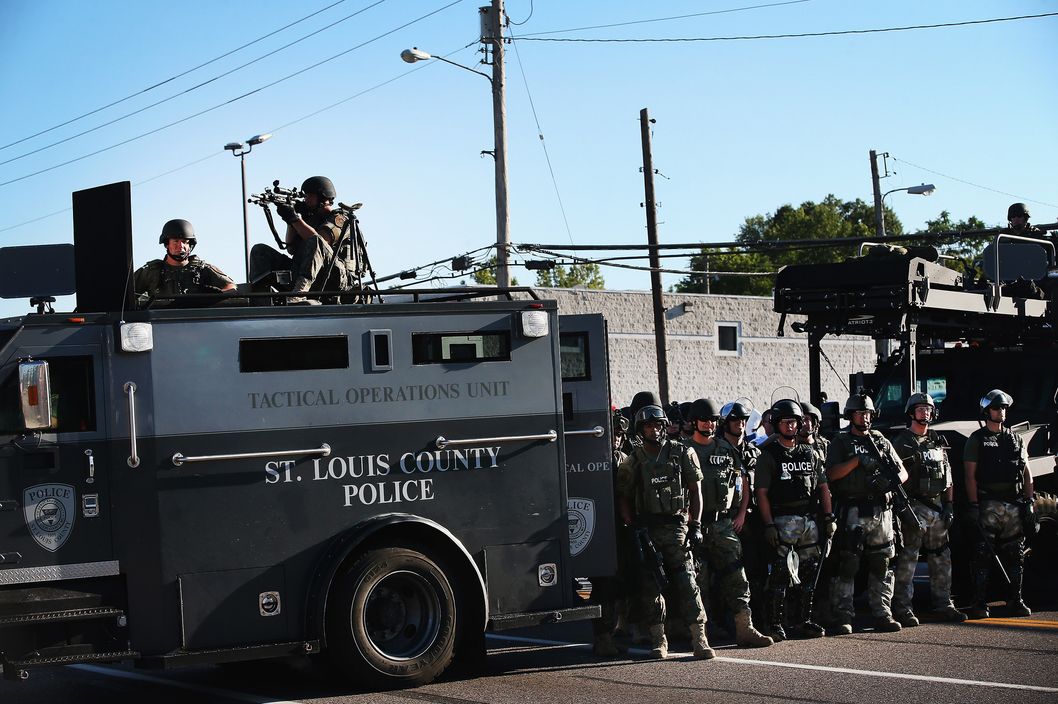In Seattle, following the 1999 WTO protests, in which violence and riots were far too common, the police department increased their tactical response ability with military-style weapons, armor, and vehicles. Following the 9/11 attack in 2001, police departments, large and small, around the country were given surplus military gear to better equip them for possible future attacks.

The images above are from the last week in Ferguson, MO, where tactical officers were called in to help police clear protestors who had taken to the streets over the police shooting of Michael Brown.
Research over the years has shown that the presence of heavily armed police increases the rate of violence and the likelihood of violence:
a great deal of social-psychological research, as well as important anecdotal evidence from law-enforcement specialists themselves, suggests that militarized policing can greatly inflame situations that might otherwise end peacefullyOne wonders if the events in Ferguson will be a wake-up for police departments to avoid the military and militaristic approach to protests.
How Militarizing Police Can Increase Violence
By Jesse SingalFollow @jessesingal

Long before the killing of Michael Brown and the subsequent protests in Ferguson, Missouri, which have brought with them countless images of heavily armored local authorities pointing guns at and firing tear gas and other nonlethal weapons at unarmed protesters, some were disturbed by what Washington Post journalist Radley Balko calls “the rise of the warrior cop” — that is, the increasing tendency of some local police forces to rely on military-style gear and tactics, even in situations that appear devoid of any real threat to officers’ safety.
The story of how this happened and the oftentimes tragic results have been well-told by Balko, the American Civil Liberties Union, and others. In short, there’s been a flood of drug-war and post-9/11 money that has helped outfit police departments, even towns where a single murder is an incredibly rare event, with gear that could help repel seasoned paramilitaries.
What’s less clear is how this gear changes the psychological dynamics of policing and crowd control. Is it true, as many people are arguing online, that “When you have a hammer, everything looks like a nail” — that is, that simply having military gear will make police more likely to act in an aggressive manner toward civilians? How does this change the relationship between police and civilians?
At the most specific level, these questions haven’t been studied empirically. But a great deal of social-psychological research, as well as important anecdotal evidence from law-enforcement specialists themselves, suggests that militarized policing can greatly inflame situations that might otherwise end peacefully.
The so-called “weapons effect” can partly explain what’s going on in Ferguson and elsewhere. The mere presence of weapons, in short, appears to prime more aggressive behavior. This has been shown in a variety of experiments in different lab and real-world settings.
“Theory underlying the weapons effect or similar kinds of phenomena would suggest that the more you fill the environment with stimuli that are associated with violence, the more likely violence is to occur,” said Bruce Bartholow, a University of Missouri social psychologist who has studied the weapons effect. Brad Bushman, a psychologist at Ohio State, agreed. “I would expect a bigger effect if you see military weapons than if you see normal weapons,” he said.
This isn’t just about a link between visual stimuli like guns and violence, however. It also has to do with the roles people adopt, with how they respond to the presence of others who may — or may not — mean them harm. To a certain extent, if you dress and treat people like soldiers facing a deadly enemy, they’ll act like it.
“This process isn't necessarily good or bad, but depends on the extent to which the more militaristic role fits the situation,” said Craig Anderson, a psychologist at Iowa State, in an email. “When it doesn't fit well, it is likely to lead to more judgment and behavior errors.” Maria Haberfeld, a professor at the John Jay College of Criminal Justice who has studied how police departments outfit themselves, said the dynamic could be particularly dangerous in the context of nonviolent protests like Ferguson (there was rioting and looting earlier this week, but there have also been widespread reports of nonviolent protests being broken up by police aggression).
“Military equipment is used against an enemy,” said Haberfeld. “So if you give the same equipment to local police, by default you create an environment in which the public is perceived as an enemy.” On the other side of these confrontations, this could have a negative effect on protesters. “We live in a democratic country, and we believe that this is our right to go out and exercise the right to [free speech],” she said. “And when you go out there and exercise that right and suddenly you are faced with soldiers — even though these are not soldiers, but police officers looking like soldiers — then something is triggered, definitely.”
Bushman said that meeting nonviolent protests with a militarized response is “really a bad idea. I can’t believe they’re doing it.” “It’s just really bad for the officers because they feel more powerful, more invincible, more militaristic, ready to attack,” he said. “And also, I think it elicits a response from the observers that, hey, this is war, and people become defensive and they have a fight/flight response.” The adoption of masks themselves in a militarized setting, on the part of police or protesters, can also contribute to violence by triggering senses of anonymity and what psychologists call deindividuation. "There's all kinds of evidence in social psychology that that will lead people to do things that they wouldn't do if they could be identified," said Bartholow.
All this militarization, said Bartholow, can be contrasted “against the old kind of beat-cop model where people in the neighborhood know the police officers’ name and he’s kind of everybody’s buddy in a sense.”
Gil Kerlikowske, the head of U.S. Customs and Border Protection and former police chief of Seattle, drew out this distinction in a striking recent interview with NPR’s Steve Inskeep. He explained that at the one-year anniversary of the damaging 1999 World Trade Organization riots, he took conscious steps to have his officers dressed like police rather than a counterinsurgency unit, which he said made it easier to deal with potentially dangerous crowds. But the police guild didn’t approve of this approach — its members wanted him to give the officers as much armor as possible.
INSKEEP: Kerlikowski paid attention [to the guild]. Though he came to wish he hadn't. The next time there were troublesome crowds it was Mardi Gras. Police did not go out in soft gear, they went out heavily protected. So, the cops felt safer but somehow the crowd became harder to control. Scores of people were injured as violence spread. Women were sexually assaulted. One man was killed as police watched.Kerlikowski, Haberfeld, and other law enforcement seem to have developed an intuitive understanding of the psychological effects of police militarization. But that may not matter, because all this surplus military gear isn’t going away — $450 million of it was distributed to police in 2013 alone. So even after things calm down in Ferguson, we’ll still be in the midst of a sweeping, potentially dangerous experiment in social psychology and criminology.
KERLIKOWSKI: Well, to tell you the truth it makes it pretty difficult when you're talking from behind a face shield with a gas mask, to engage with the public and say, look let's tone this down, let's calm things down, let's make sure that those people that need to be apprehended are arrested because of their intoxicated state, their level of violence etc. It's pretty hard to engage in those discussions when you're hardened up. I regret that - today. I should've stuck by my decision earlier, I didn't.
“Even in my small midwestern town, the police no longer drive a standard police cruiser,” Bartholow said. “They drive these kind of big SUVs — they almost look like military humvees, and they’re more intimidating looking.”
No comments:
Post a Comment